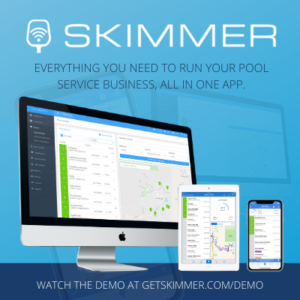Technology in the Pool Industry: Phone App that Connects Pool Pros with Pool Owners
Technology like phone apps, computer programs for monitoring chemical levels, and other advanced technology are and will continue to evolve. The technology can be viewed as helpful to the consumer or pool pro or it may be early in its inception to meet their needs as of yet. People will continue to use technology to make their lives and jobs easier. This is an example of a phone app that is available on the Android and iPhone platforms. Your decisions as a pool operator are all going to vary depending on your company’s unique needs and wants. Please have a open mind with any technology that is initially introduced and make your own decision without malice against other. It’s not a “one size fits all.”
—Lauren Broom, Space Coast Pool School, LLC

Author: Santo Leo, Co_Founder & CEO /Pool Today
Turn your pool truck into a Ferrari. Pilot by PoolToday is now live! Early bird special promo at the end of this blog. Have you ever thought about having your own on-demand mobile app for pool service?
We hear this all the time “I had this idea!” from Pool Pros we interview to join PoolToday, the first marketplace that connects Pool Pros with Pool Owners, without having to pay for leads.
Since officially launching PoolToday about two months ago, we have been inundated with Pool Pro sign ups and customers from so many different parts of the country that we have been struggling to keep up.

This is a great problem for a startup to have, but my co-founders and I have been frustrated, because we obviously want to grow as fast as possible, especially since our software is built to work nationwide and customers who are on it love it (we have a perfect NPS score based on anonymous user feedback).
Additionally, we know PoolToday has helped Pool Service Pros in Florida. We have found that customers are 30% more likely to pay for parts and repairs through our app than without it. In fact, in a matter of weeks we have expanded from just pool service to offering over a dozen different products and services.
However, our problem is that in some markets we have 20+ Pool Pros trying to join in the same city. How do we decide who is accepted? It’s a complicated process, and slow. And to add to this issue, we have customers signing up in markets that we did not plan to launch for years. We have bene primarily focused on the sun belt.
America is HUGE. There are 30,000+ zip codes! We realize it will take us years to efficiently launch a marketplace in every one of them, with the right number of customers and contractors. My co-founders and I have spent a lot of time trying to come up with a solution on how to launch markets faster. Then we got a bit of inspiration….

After listening to a podcast by the Founder of Poshmark, it turned out Poshmark had this same problem: too many sellers were joining their platform, and that didn’t necessarily mean a better experience. Poshmark then implemented a fee to the seller and was able to focus on the top sellers who were (actually) going to invest the time into innovating and growing their business.
We started thinking:
What if Pool Pros could use our technology for their own route management AND get the benefits of new customers from PoolToday’s marketplace?
We do not set prices, we actually help pros charge MORE, here's how:
- Pool pros tell us what to charge. If there are multiple pros we average what they are telling us. If it’s their own market with Pilot, they get to choose entirely. But, either way, pros tell us what to charge.
- We also bill every service, so that’s 52 weeks of paid service whereas the average pro typical doesn’t get paid for all 52 weeks.
- Also, the way our soft ware is setup the customer doesn’t get a price for a job. The pro sets flat rate pricing. So instead of the customer shopping amazon for a filter and haggling, the ability for them to just see the price in the app has a psychological effect that helps induce them into buying, Think about it: did you spend more money before or after buying from amazon? ‘They aren’t always the cheapest: it’s the ease of purchase that induced you to spend more.
Having to get up, leave the house, shop, stand at a register, slowed the process down and in turn made you double think whether you really needed to buy that thing. When you can open your phone and tap a button, there is less friction. So they become more likely to buy.





